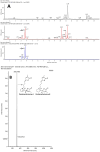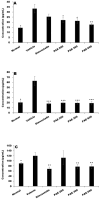Pandanus amaryllifoius Roxb. Leaves Ethanol Extract Ameliorates Lipid and Proinflammatory Cytokines Profiles in a Rat Model of Dyslipidemia
- PMID: 38948314
- PMCID: PMC11194525
- DOI: 10.3831/KPI.2024.27.2.101
Pandanus amaryllifoius Roxb. Leaves Ethanol Extract Ameliorates Lipid and Proinflammatory Cytokines Profiles in a Rat Model of Dyslipidemia
Abstract
Objectives: Dyslipidemia has currently become a major health challenge that still opens for safer and more effective modes of treatment. The plant Pandanus amaryllifolius Roxb. (pandan) has been indicated to contain active ingredients that interfere with the pathological pathway of dyslipidemia. The aim of the study was to test the effects of pandan leaves ethanol extract on lipid and proinflammatory profiles in a rat dyslipidemic model.
Methods: Dyslipidemia was induced by administration of high-fat feed for 8 weeks. Treatments (vehicle, the reference drug simvastatin at 1.8 mg/kg, and extract at 200, 300 or 600 mg/kg) were given for 4 weeks following the completion of induction.
Results: Significant post-treatment decreases in total cholesterol, low density lipoprotein (LDL), and triglyceride levels in groups receiving all doses of extract and simvastatin were observed. Similar results were also found in regards to proinflammatory cytokines levels. Pandan extracts significantly lowered the concentrations of IL-6, TNF-α, and NFκB p65. Characterization of metabolite contents of the extract confirmed the presence of the previously suggested active alkaloids pandamarilactonine-A and B.
Conclusion: Taken together, results of the present study implied the ameliorating effects of pandan leaves ethanol extract in dyslipidemic condition which is potential for opening an avenue in combating this essential component of metabolic disorder.
Keywords: Pandanus amaryllifoius Roxb; dyslipidemia; ethanol extract; leaves; pandan; rats.
© 2024 Korean Pharmacopuncture Institute.
Conflict of interest statement
CONFLICTS OF INTEREST The authors declare no conflicts of interest in this work.
Figures



Similar articles
-
Ultrasonic Extraction of 2-Acetyl-1-Pyrroline (2AP) from Pandanus amaryllifolius Roxb. Using Ethanol as Solvent.Molecules. 2022 Jul 31;27(15):4906. doi: 10.3390/molecules27154906. Molecules. 2022. PMID: 35956856 Free PMC article.
-
The effects of Pandanus amaryllifolius (Roxb.) leaf water extracts on fructose-induced metabolic syndrome rat model.BMC Complement Altern Med. 2019 Aug 28;19(1):232. doi: 10.1186/s12906-019-2627-0. BMC Complement Altern Med. 2019. PMID: 31462242 Free PMC article.
-
The Potential Combination of Noni (Morinda citrifolia) Fruit Extract and Pandan (Pandanus amaryllifolius Roxb.) Leaves Extract as an Anti-Dandruff Shampoo.J Pharm Bioallied Sci. 2021 Nov;13(Suppl 2):S1369-S1374. doi: 10.4103/jpbs.jpbs_205_21. Epub 2021 Nov 10. J Pharm Bioallied Sci. 2021. PMID: 35017991 Free PMC article.
-
Ultrasound-assisted encapsulation of Pandan (Pandanus amaryllifolius) extract.Ultrason Sonochem. 2021 Nov;79:105793. doi: 10.1016/j.ultsonch.2021.105793. Epub 2021 Oct 15. Ultrason Sonochem. 2021. PMID: 34673338 Free PMC article. Review.
-
Final report on the safety assessment of capsicum annuum extract, capsicum annuum fruit extract, capsicum annuum resin, capsicum annuum fruit powder, capsicum frutescens fruit, capsicum frutescens fruit extract, capsicum frutescens resin, and capsaicin.Int J Toxicol. 2007;26 Suppl 1:3-106. doi: 10.1080/10915810601163939. Int J Toxicol. 2007. PMID: 17365137 Review.
References
LinkOut - more resources
Full Text Sources
